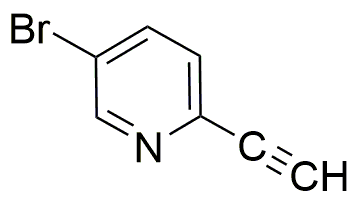5-Bromo-2-ethynylpyridine is widely utilized in research focused on:
- Pharmaceutical Development: This compound is a key intermediate in the synthesis of various pharmaceuticals, particularly in creating novel drugs that target specific biological pathways.
- Material Science: It is used in the development of advanced materials, including polymers and coatings, due to its unique chemical properties that enhance material strength and durability.
- Organic Synthesis: Researchers leverage its reactivity in organic synthesis to create complex molecules, making it valuable in academic and industrial laboratories for producing fine chemicals.
- Biochemical Research: The compound serves as a probe in biochemical studies, helping scientists understand enzyme mechanisms and interactions within biological systems.
- Agricultural Chemistry: It finds applications in the formulation of agrochemicals, contributing to the development of effective pesticides and herbicides that improve crop yields.
Informations générales
Propriétés
Sécurité et réglementation
Applications
5-Bromo-2-ethynylpyridine is widely utilized in research focused on:
- Pharmaceutical Development: This compound is a key intermediate in the synthesis of various pharmaceuticals, particularly in creating novel drugs that target specific biological pathways.
- Material Science: It is used in the development of advanced materials, including polymers and coatings, due to its unique chemical properties that enhance material strength and durability.
- Organic Synthesis: Researchers leverage its reactivity in organic synthesis to create complex molecules, making it valuable in academic and industrial laboratories for producing fine chemicals.
- Biochemical Research: The compound serves as a probe in biochemical studies, helping scientists understand enzyme mechanisms and interactions within biological systems.
- Agricultural Chemistry: It finds applications in the formulation of agrochemicals, contributing to the development of effective pesticides and herbicides that improve crop yields.
Documents
Fiches de données de sécurité (FDS)
La FDS fournit des informations de sécurité complètes sur la manipulation, le stockage et l’élimination du produit.
Spécifications du produit (PS)
Le PS fournit une description complète des propriétés du produit, notamment sa composition chimique, son état physique, sa pureté et les exigences de stockage. Il détaille également les plages de qualité acceptables et les applications prévues du produit.
Certificats d'analyse (COA)
Recherchez des certificats d'analyse (COA) en saisissant le numéro de lot du produit. Les numéros de lot et de lot se trouvent sur l'étiquette d'un produit, après les mots « Lot » ou « Lot de fabrication ».
Numéro de catalogue
Numéro de lot/série
Certificats d'origine (COO)
Ce certificat d'exploitation confirme le pays dans lequel le produit a été fabriqué, et détaille également les matériaux et composants utilisés et s'il est issu de sources naturelles, synthétiques ou autres sources spécifiques. Ce certificat peut être requis pour les douanes, le commerce et la conformité réglementaire.
Numéro de catalogue
Numéro de lot/série
Fiches de données de sécurité (FDS)
La FDS fournit des informations de sécurité complètes sur la manipulation, le stockage et l’élimination du produit.
DownloadSpécifications du produit (PS)
Le PS fournit une description complète des propriétés du produit, notamment sa composition chimique, son état physique, sa pureté et les exigences de stockage. Il détaille également les plages de qualité acceptables et les applications prévues du produit.
DownloadCertificats d'analyse (COA)
Recherchez des certificats d'analyse (COA) en saisissant le numéro de lot du produit. Les numéros de lot et de lot se trouvent sur l'étiquette d'un produit, après les mots « Lot » ou « Lot de fabrication ».
Numéro de catalogue
Numéro de lot/série
Certificats d'origine (COO)
Ce certificat d'exploitation confirme le pays dans lequel le produit a été fabriqué, et détaille également les matériaux et composants utilisés et s'il est issu de sources naturelles, synthétiques ou autres sources spécifiques. Ce certificat peut être requis pour les douanes, le commerce et la conformité réglementaire.


